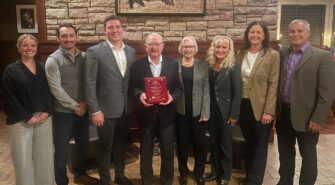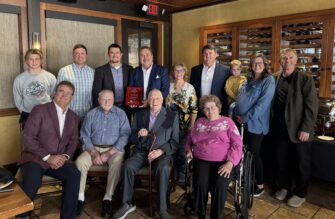Multigenerational ranch, lodge to host family business retreat
Recent News
Transition resources help family-owned banks prepare for succession
Posted in Member News | December 2, 2022
Published on by Jacqueline Nasseff Hilgert at bankbeat.biz
Within families that own banks, there can be a disconnect between parents who control the bank and children in line to take their place. Some parents struggle to see their grown children as fully-realized adults while members of the rising generation might view parents as out-of-touch and ready for pasture, having had enough time at the helm as primary shareholder or chief executive, or both. “I’ve seen a number of banks that had a great management team, but the dad was tired of dealing with the kids,” said David Johnson, chair and CEO of Estelline, S.D.-based Reliabank.

When family members cannot navigate their way past their own drama to focus on the future of the institution, it’s likely the bank gets sold, explained Johnson, who has called failed succession the greatest threat to the future of family-owned banks. Johnson and his family have been intentional about succession planning to avoid selling Reliabank.
Likewise the Larson family, owners of Bismarck, N.D.-based Starion Bank, has focused its attention on successfully transitioning leadership.
The succession issues at play in family businesses are multitude, and extend beyond personality conflicts or sibling grudges harbored since middle school. Succession at family-owned banks involves a change in ownership and quite possibly a change in leadership. It often unfolds against an elder’s fierce resistance to change. Succession can impact employees, customers and the community, the latter especially when it fails and leads to a sale.
Succession at a family bank forces to the table the same issues people have been cautioned to avoid at mealtimes: Money and death (and taxes!). To navigate the fraught landscape of succession within the family business, there exist non-profit organizations and university outreach programs, including the organization the Johnson and Larson families, among others, have turned to — the Prairie Family Business Association. Programs sponsored by the PFBA are helping Upper Midwest bankers, and other owners of family businesses, figure out how to beat odds that say only 40 percent of family-owned businesses turn into second-generation businesses, and only 13 percent are successfully passed to the third generation.
Fostering dialogue

Successful transitions at family banks start with communication, said Stephanie Larscheid, executive director of the PFBA, which boasts a membership of 237 family-owned businesses active in many sectors. “Families who struggle don’t give themselves the space to talk about what the future looks like and how they’re going to get there,” Larscheid said.
The PFBA was formalized 31 years ago within the University of South Dakota’s Beacom School of Business. It offers an outreach center, off-site retreats, annual programs, connections to outside professionals that specialize in helping families in transition, and a peer network. Its members own businesses in 13 states, with a majority operating within a 350-mile radius of its office in Sioux Falls, S.D.
Similar resources are accessible through the Kellogg School at Northwestern University in Evanston, Ill., the New England-based Institute for Family-Owned Businesses, and the Ohio-based Conway Center for Family Business, to name a few.
Johnson, 70, began his career at Reliabank in the 1970s. He was 24 when his father died unexpectedly. Keeping the bank in the family required Johnson to keep the bank going, and it took him more than a decade to pay off the estate taxes. He eventually bought out his siblings to become sole owner. He and his wife, Jan, got involved with the PFBA to puzzle through how to keep their bank family-owned if neither of their two sons ever became CEO. Both sons work at Reliabank: Reid Johnson, 39, is director of marketing and Ethan Johnson, 32, works in finance and aspires to become CFO.
The Johnsons joined a PFBA-sponsored retreat at the Paul Nelson Farm, a pheasant-hunting lodge in Gettysburg, S.D., which offered them sweeping vistas, requisite detachment from work-a-day concerns, and the space to have meaningful intergenerational dialogue mediated by a counselor assigned to them by the PFBA. Johnson said the retreat was transformational for their family; in such space, “parents learn to treat children as adults,” he said, and “children begin to think in more mature ways about their sibling relationships and about their parents. I think that’s the key thing.”
It was Craig Larson, executive chair of Starion who’d urged the Johnsons to engage with PFBA. Larson engaged with PFBA in the early 2000s and eventually served the association as chair.
“The families who are successful take time away from the business to talk,” Larscheid said. The most fruitful discussions occur, she added, when everyone is removed from distractions in order to focus on learning what matters in the context of a transition.
“Our ideal family in our membership is someone who is open-minded and willing to spend time working on their business,” Larscheid said. “They show up saying, ‘we don’t know what we don’t know, and we want to learn more.’”
The PFBA retreat at the Nelson farm was expensive, Johnson said, yet it yielded dramatic results at a pivotal point in their family’s succession journey.
Who leads next?
This past fall, PFBA held a Next-Gen Retreat to help family businesses tackle succession from the perspective of the rising generation. Thirty-year-old Samuel Domke, loan officer and part of the third generation to work at Heartland State Bank in Redfield, S.D., attended.

The retreat was motivating and inspirational, Domke said, with a program that included goal setting. “My goal is to get more involved in learning about the bank’s day-to-day operations,” he said. “I’ve been focused on lending. Now I want to get a broader picture of how things work,” which includes looking at operations. He said he’s especially interested in learning how the bank invests.
Like Johnson’s sons, Domke works in a different branch from his father, yet unlike them, Domke is firmly intent on becoming president/CEO, a role currently held by 57-year-old Paul Domke. With the enthusiasm of youth, Samuel Domke proffered a five-year timeline for transition to leadership, complications notwithstanding.
And with family succession, there are always complications as familial ties can bind uncomfortably and can often snap. Lawyers are needed to draw boundaries, and ownership more often than not flows inside bloodlines. Domke grew up one of five siblings, but only one sister and he are eligible to claim ownership when the opportunity presents. “My sister and I get along,” he said. “I’d say neither one of us wants the other to struggle and she has no desire to be CEO.”
Domke has two cousins, however, sons of his uncle Scott Domke, the bank’s CFO and half-owner. While the youngest cousin is still in high school and the older one has heretofore shown no interest in the bank, either one could decide they want to work toward leadership. This third generation of Domkes is exactly the target market for the PFBA, people in their 20s to mid-40s who are figuring out how to be business owners.
Rules of ownership
Transitions that fail do so largely because of a lack of preparation in the next generation, said Larry Hause, an attorney and principal at Hause Family Business Transitions in Minneapolis. Succession, he said, requires a plan to transition all three parts of the family business: The family, the ownership, and the management. Each transition opens the door to conflict about who’s included (family), who controls the wealth (ownership), and who wields the power (management).

“A lot of [decisions] will involve a family council,” Larscheid said. “A lot of it involves some of the traditions and meanings. Teaching the next generation, ‘This is why we’re in business. This is our purpose. This is what we do. This is why we believe in our business and why we want it to live on.’”
Hause prefers an owners’ council or ownership group be formed that is distinct from a family council in order to keep family issues from encroaching on ownership decision making. He also recommends that a manual be created that explains how the owner(s), board and management should work together.
Sometimes called “rules of ownership,” such a document dictates key actions: How are decisions made? What type of board arrangement is appropriate? When might the bank consider selling? How are disagreements mediated? Who qualifies for stock? Who qualifies for compensation?
For instance, some families, such as Domke’s, require that you work in the bank to qualify for ownership. “No one just gets to collect a check for doing nothing,” Samuel Domke said.
When well-crafted, the document will address one of the stickiest issues facing owners in transition: Fairness (all things considered) versus equality (all things the same).
At their essence, rules of ownership are a tool to communicate intent. “Bankers are hugely community-focused, so when they sell, it hurts the town,” Hause said. It’s important that successors in both ownership and management buy into that ethos.
At Reliabank, management succession involves non-family. In 2019, the bank promoted Joshua Hogue, 41, to president and Jeremy Keiser to Sioux Falls market president. “We’ve been very lucky to recruit the people we’ve gotten,” Johnson said. “They’ve bought into the family-owned community bank model.”
At Starion, management also relies on non-family. Don Morgan was chosen to lead after going through a deliberate vetting process. “Honestly, a lot of the things we’re doing in our bank are things we were exposed to through the Prairie Family Business Association,” Larson said in an article published by the PFBA.
In other cases, when the business was founded for other reasons, “maybe the exit strategy is to sell,” Hause said. For those in the rising generation, “it’s good to know that,” he said.
But if it’s not to sell, the rising generation needs a timeframe and ongoing discussions and plans to figure out how to keep the bank going. The conversation from the rising generation to the senior generation should go something like this, Hause said: “I think you built a really great business and I’d like to be a part of it … I’d like to work with you so you can be a part of it as long as you want to be, and I can be a part of it too. So we can accomplish what we both want.
“Put them in a bind where they realize they need help and the next generation is there to provide it,” Hause advised.

The pigeon on the ledge
In transition, there are situations that arise that one cannot anticipate, explained Jan Johnson, who also works at Reliabank. The network offered by PFBA is invaluable when facing a situation you hadn’t considered, she said.
Members of the rising generation participating in a recent PFBA webinar talked of a parent who kept pushing transition timelines and a parent who left but then later returned. “One of our families describes it as a pigeon,” Larscheid said. “It comes in when it wants and maybe when you don’t want it to. What can be helpful in those situations is when you have a board of directors or a family board or an ownership group, and you have a way for that senior generation to contribute in a meaningful way.”
The process demands so much of people, not the least of which is time. A 60-year-old president/chair/owner could be working for 20 to 30 years more. And for the successor who faces an interminable wait (e.g., King Charles III), walking away is a viable, sometimes life-saving option. “If you don’t have a walk-away plan, it’s to your detriment,” Hause said.
Research conducted at the Johnson College of Business at Cornell University in Ithaca, N.Y., reveals that almost one third (30.5 percent) of family business owners have no plans to retire. Ever. And, 29.2 percent of owners report that their retirement is more than 11 years away.
One of the worst ways to open a conversation about succession, Hause said, is to push retirement. Entrepreneurs, founders, banking leaders, “they aren’t interested in retirement.”
Johnson wholeheartedly agrees. “When you are in the banking business, you feel a part of the success of customers. There is a bonding that goes on there. It’s hard to walk away from that.” Johnson dubbed the effect “intoxicating.”
But while he admits there’s allure in staying, the perfectionist in him is resolute about stepping down in 2025. “I’m going to walk away; I have to,” he said.
“There’s a lot of, ‘It’s tough letting go when the business is your baby,’” Larscheid said. “You don’t want to let it go. Maybe the next generation is ready. You may have your key executive leadership. But you love what you do. And so you’re not ready to step away.”
Larscheid recommends families start talking and planning 10 to 15 years ahead of a probable transition date.
Hause recommends the next generation broach the topic of succession with the right attitude. If the rising generation leads with “I know better,” Hause said they will fail. “Ask mom and dad what they want to do about their business,” he said. “Ask what they want their legacy to be. Invite them to dream. Listen, plan, and then be patient.”




